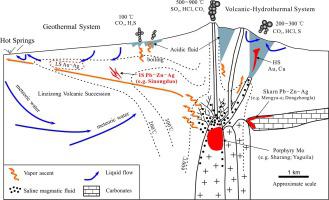当前位置:
X-MOL 学术
›
Ore Geol. Rev.
›
论文详情
Our official English website, www.x-mol.net, welcomes your feedback! (Note: you will need to create a separate account there.)
Geology, geochronology, and geochemistry of the Sinongduo Ag–Pb–Zn deposit in the Gangdese Metallogenic Belt: Implications of intermediate sulfidation mineralization in the Linzizong volcanic succession
Ore Geology Reviews ( IF 3.3 ) Pub Date : 2020-12-01 , DOI: 10.1016/j.oregeorev.2020.103796 Zongyao Yang , Xiaoyan Zhao , Guyue Hu , Ying Wang , Fengqin Ran , Yiru Huang , Xin Wu , Jinyue Hao , Hongtian Xiao
Ore Geology Reviews ( IF 3.3 ) Pub Date : 2020-12-01 , DOI: 10.1016/j.oregeorev.2020.103796 Zongyao Yang , Xiaoyan Zhao , Guyue Hu , Ying Wang , Fengqin Ran , Yiru Huang , Xin Wu , Jinyue Hao , Hongtian Xiao

|
Abstract The Sinongduo Ag–Pb–Zn deposit was first defined as a typical low sulfidation (LS) epithermal deposit in the widespread Linzizong volcanic succession (LVS), Gangdese belt, Tibet. This paper we describe the lithology, mineralization, and hydrothermal alteration based on current advances in exploration, and use multiple chemical and geochronology methods, including whole-rock geochemistry (major and trace elements) of ores and the lithocap, the mineral chemistry of sphalerite, and the LA–MC–ICP-MS zircon U–Pb dating of host volcanic rocks to better constrain the genesis of the Sinongduo deposit and give some exploration advice. In the Sinongduo deposit, the host crystal tuff yields a zircon U–Pb age of 61.9 ± 0.4 Ma, indicating nearly simultaneous diagenesis and mineralization. The metallic minerals are mainly FeS-poor sphalerite, galena, pyrite, and minor chalcopyrite, along with silver and silver-based precious minerals. These minerals, particularly FeS–poor sphalerite, pyrite, and chalcopyrite, represent IS states. Mineral chemistry shows that the content of FeS in sphalerite is lower than 4.94 mol% and the Ag concentration is quite high, ranging from 16 to 1798 ppm with a mean concentration of 245 ppm. Low Ga/in ratios (
更新日期:2020-12-01



























 京公网安备 11010802027423号
京公网安备 11010802027423号